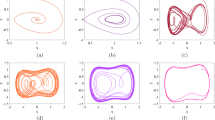Abstract
A detection scheme for line spectrum of ship-radiated noise is proposed using Duffing oscillator. The chaotic trajectory of Duffing oscillator is analyzed and the state equation of the system is improved to detect weak periodic signals in different frequencies. According to the simulation results, the phase transforms of Duffing oscillator are sensitive to periodic signals and immune to the random noise and the periodic interference signals which have larger angular frequency difference from the referential signal. By employing Lyapunov exponents in the field of detection as the criteria for chaos, the phase transforms of dynamic behaviors in quantity are successfully determined. Meanwhile, the threshold value in critical state has been evaluated more accurately. Based on the phase transforms of Duffing oscillator, a new method for detecting line spectrum of ship-radiated noise is given. Three types of ship-radiated noise signals are analyzed and the values of line spectrum are acquired successfully by this method. The experimental results show that this method has high sensitivity and high resolution.
Similar content being viewed by others
References
Zhu X Q, Wu W S. Prediction of line-spectrum noise induced by high speed vehicle contra-rotating propellers in water. J Ship Mech, 1997, 1(1): 44–56
Lourens J G. Classification of ships using underwater radiated noise. In: Proceedings of IEEE Communications and Signal Processing. Pretoria: IEEE Press, 1988. 130–134
Vaccaro R J. The past present and future of underwater acoustic signal processing. IEEE Signal Proc Mag, 1998, 15(4): 21–51
Mo X H, Tang G N. Study on phase synchronization of chaotic oscillators with many rotational centers based on amplitude coupling. Acta Phys Sin, 2004, 53(7): 2080–2083
Gao X, Yu J B. Chaos in the fractional order periodically forced complex Duffing’s oscillators. Chaos Soliton Fract, 2005, 24: 1097–1104
Li Y, Yang B J, Yuan Y. Ability of detecting a weak effective seismic signal by using chaotic oscillator system. Chin Sci Bull, 2006, 51(24): 3010–3017
Li Y, Yang B J. Chaotic system for the detection of periodic signals under the background of strong noise. Chin Sci Bull, 2003, 48(5): 508–510
Liu Z R. Perturbation Criteria for Chaos. Shanghai: Shanghai Scientific and Technology Education Press, 1994. 36–48
Wang G Y, He S L. A quantitative study on detection and estimation of weak signals by using chaotic duffing oscillators. IEEE Trans Circuits Syst, 2003, 50(7): 945–953
Wolf A, Swift J B, Swinney H L, et al. Determining Lyapunov exponents from a time series. Physica, 1985, 16: 285–317
Ciraolo G, Chandre C, Lima R. Controlling chaotic transport in a Hamiltonian model of interest to magnetized plasmas. J Phys A Math Gen, 2004, 37: 3589–3597
Michael T R, James J C, Carlo J D. A practical method for calculating largest Lyapunov exponents from small data sets. Physica D, 1993, 65(1–2): 117–134
Author information
Authors and Affiliations
Additional information
Supported by the National Natural Science Foundation of China (Grant No. 10474079) and a major project of National Defense Science and Technology (Grant No. 41303080301)
About this article
Cite this article
Zheng, S., Guo, H., Li, Y. et al. A new method for detecting line spectrum of ship-radiated noise using duffing oscillator. Chin. Sci. Bull. 52, 1906–1912 (2007). https://doi.org/10.1007/s11434-007-0271-4
Received:
Accepted:
Issue Date:
DOI: https://doi.org/10.1007/s11434-007-0271-4




